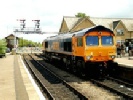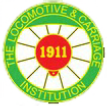Archive Section




© By Peter Lindop
This article was written after the visit to North Pole in March 1996. Unfortunately the European Night Stock refereed to in the article were never introduced on services from the UK to Europe and have recently been sold to Canada. The 14 North of London Eurostars also never entered service on their intended rle and instead have either been mothballed or hired to Great North Eastern Railways for use on the "White Rose" services between London Kings Cross and York.
For the first visit of the 1996 season a group of 20 assembled in a reception room at North Pole International Depot (West London) on Wednesday 27 March, the majority having used the staff mini-
We were then formed into three groups, led by Mick and Team Technicians Andy Bowdidge and Michael Clarke. My group first went to see the control room, which deals with the maintenance planning, overhead line isolations, via Willesden Electrical Control Operators, and has an N-
Now walking under the West London Line, which splits the site in half, we passed the arrival sidings, one of which can be switched to any of the three types of power systems for train testing, and came to the Service Shed on the western half of the site. This is six roads wide, each capable of holding a full 20 vehicle long “Eurostar” train. After seeing and following isolation procedures we went onto the high walkway that gives access to the train roof. This walkway is just over the length of the power car and allows easy examination of the equipment. There are two pantographs on each power car: a Brecknell Willis one for the Belgian 3kV DC system and a Stone Faiveley one for the French and Eurotunnel 25kV AC systems. The power is taken via busbars and breakers into the power car.
Returning to the ground we had a look at the front of the car, seeing the emergency Scharfenberg coupling behind retractable covers, and a lower skirt that had just been changed, damaged by a fox; which also had to been removed!. Then we climbed into the cab, a bit of a squeeze for a group! All the controls and gauges were explained. The main switch has seven positions -
Passing through the Service Shed we headed beck to the reception room. All groups joined for a fine buffet lunch, during which more questions were answered. We heard something about the Night Sleeper stock, delivery of which is expected from late summer and the North of London Regional ‘Eurostar’ sets. These trains are a shorter, being of 14-
The afternoon started with a look in the Maintenance Workshop, our guide being Brian Harris. This is four roads wide and is 10 vehicles long, enough for one half set. A plaque on the wall records the official opening of the depot on 11 November 1992 by British Rail Chairman, Sir Bob Reid. Lifting work is carried out in this workshop with 26 jacks located on number 4 road. A complete half set can be lifted in one go, using 24 jacks all controlled from one switch panel. The height difference end-
Our next building visited was the Bogie Drop Shed. In the middle is a large hole about 40 feet deep crossed by a moveable bridge, rated at 60 tonnes fixed and 40 tonnes moving. After positioning a train on stands, a wheelset or bogie is uncoupled and lowered into the pit by the huge scissors jack equipment. The bridge then transverses across and is raised to the next road, when the process is reversed with the new component. Quite an amazing piece of equipment! A 40 tonne overhead crane is also in the shed.
Next we walked down to the Wheel Lathe shed, almost at the eastern end of the site. This houses two German Hoesch centre turning lathes, which are moveable to allow different wheelbase axles to be done together. Again, unfortunately the shed was empty, but an assortment of other locomotives and units have been turned as well as Eurostars.
Our final visit was to the International Stores Complex; this is the main stores for the three Eurostar depots. On the vast area of shelving are held almost enough items to make a complete train and outside even seen spare cab shells were seen. There are about 1600 different items on the shelves.
Finally we headed back again to the reception room, at the end of a very interesting visit. We spent more time than anticipated, walked quite a distance, sometimes at a pace, but still there was not enough time to see everything. Many thanks go to Mack and his colleagues for a very enjoyable day.